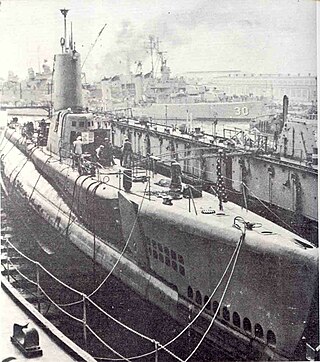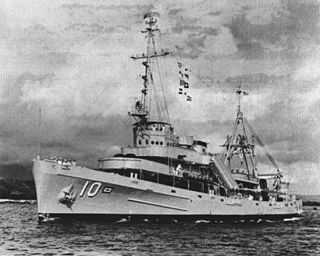
USS Arnold J. Isbell (DD-869), a Gearing-class destroyer, was the only ship of the United States Navy to be named for Arnold J. Isbell, an aircraft carrier captain during World War II. The ship was laid down on 14 March 1945 at Staten Island, New York, by Bethlehem Mariners Harbor, launched on 6 August 1945 and commissioned on 5 January 1946. Constructed too late to see action in World War II, the vessel initially served as a training ship with the United States Atlantic Fleet, before transferring to the Pacific and deploying to Korea during the Korean War and off the Vietnam coast during the Vietnam War. In 1972 Arnold J. Isbell was made part of the reserve training fleet and in 1974, sold to Greece where the ship was renamed Satchouris and served with the Hellenic Navy until being sold for scrap in 2002.

USS Blueback (SS-581) is a Barbel-class submarine that served in the United States Navy from 1959 to 1990, and subsequently was made into an exhibit at the Oregon Museum of Science and Industry. She was the second Navy submarine to bear the name.

USS Sailfish (SSR/SS/AGSS-572), the lead ship of her class of submarine, was the second ship of the United States Navy to be named for the sailfish, a large gamefish inhabiting tropical seas, related to the swordfish, but possessing scales and a large sail-like dorsal fin.

USS Tang (SS/AGSS-563), the lead ship of her class was the second ship of the United States Navy to be named for the tang.

USS Volador (SS-490), a Tench-class submarine, was the second ship of the United States Navy to be named for the volador.
USS Trigger (SS-564), a Tang-class submarine, was the second ship of the United States Navy to be named for the triggerfish.

USS Wahoo (SS-565), a Tang-class submarine, was the second ship of the United States Navy to be named for the wahoo, a dark blue food fish of Florida and the West Indies.

USS Towers (DD-959/DDG-9) was a Charles F. Adams-class guided missile destroyer of the United States Navy notable for action in the Vietnam War. The ship was named in honor of Admiral John Henry Towers.

USS Sculpin (SSN-590), a Skipjack-class nuclear-powered submarine, was the second ship of the United States Navy to be named for the sculpin.

USS Snook (SSN-592), a Skipjack-class submarine, was the second ship of the United States Navy to be named for the common snook, an Atlantic marine fish that is bluish-gray above and silvery below a black lateral line.

USS Medregal (SS-480/AGSS-480), a Tench-class submarine, was the only ship of the United States Navy to be named for the medregal, a streamlined, fast-swimming, bluish-colored fish of the jack family which abounds in waters of the West Indies and in the Atlantic as far north as the Carolinas.

USS Bream (SS/SSK/AGSS-243), a Gato-class submarine, was the first ship of the United States Navy to be named for the bream. She served during World War II, and her war operations extended from 1 June 1944 to 15 June 1945. During this period she completed six war patrols operating in the Java Sea, Celebes Sea, Sulu Sea, South China Sea, and Gulf of Siam. She sank two Japanese merchant ships totaling 6,934 gross register tons. In addition, Bream shared with the submarines USS Ray (SS-271) and USS Guitarro (SS-363) the destruction of a 6,806-gross register ton passenger-cargo ship. On 23 October 1944, while patrolling off western Luzon, Bream made a daring surface attack on a Japanese naval force, damaging the heavy cruiser Aoba.

USS Blackfin (SS-322), a Balao-class submarine in commission from 1944 to 1948 and from 1951 to 1972, was a ship of the United States Navy named for the blackfin cisco, a food fish of the Great Lakes.

USS Ronquil (SS-396), a Balao-class submarine, was the only ship of the United States Navy named after the ronquil, a spiny-finned fish found along the northwest coast of North America. It has a single dorsal fin and a large mouth and resembles the tropical jawfish.

USS Tiru (SS-416), a Balao-class submarine, was a vessel of the United States Navy named for the tiru, a member of the lizardfish family.

USS Agerholm (DD-826) was a Gearing-class destroyer of the United States Navy. She was the only ship named for Harold Crist Agerholm, a Private First Class (Pfc.) in the 2nd Marine Division of the United States Marine Corps. He was killed during the assault on Saipan, and posthumously awarded the Medal of Honor.

USS Samuel Gompers (AD-37) was a destroyer tender, the first of her class, and designed to be a floating repair shop for ships of the U.S. Navy either in port or at sea. The vessel was named for Samuel Gompers, a distinguished American labor leader during the late nineteenth century.

USS Henderson (DD-785) was a Gearing-class destroyer of the United States Navy, the second Navy ship of that name, and the first named for United States Marine Corps Major Lofton R. Henderson. The previous Henderson was named for Marine Corps Commandant Archibald Henderson.

USS Bausell (DD-845) was a Gearing-class destroyer in the United States Navy during the Korean War and the Vietnam War. She was named for Marine Corporal Lewis K. Bausell (1924–1944), who was awarded the Medal of Honor posthumously for "conspicuous gallantry" during the Battle of Peleliu.

USS Greenlet (ASR-10) was a Chanticleer-class submarine rescue ship in service with the United States Navy from 1943 to 1970. In June 1970, the ship was transferred to the Turkish Navy, renamed TCG Akin (A-585) and remained in service until 2017.



















